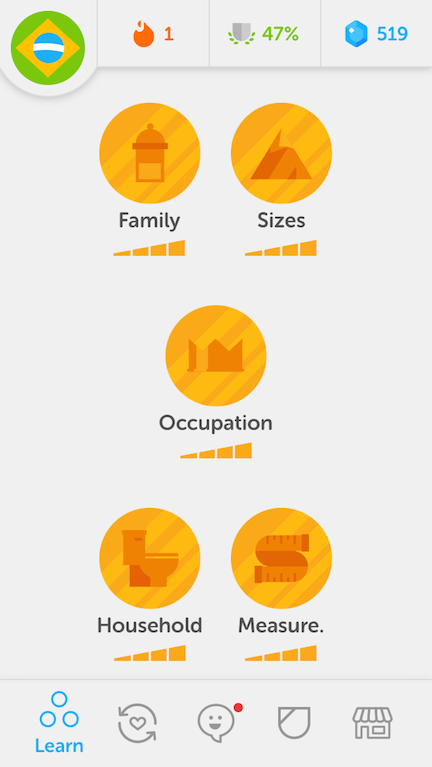Homeschool Language Learning Apps: Duolingo (The Good)
/Welcome to my series on homeschool language learning apps!
Over the next two weeks, I’ll be reviewing two of the most popular language learning apps used by homeschoolers: Duolingo and Mango Languages.
What can you expect from this series? Well, I’ll be providing in-depth reviews of each app from the perspective of both a language educator and a homeschool mom. I hope that these will help you to evaluate these tools from all angles in order to determine whether or not they are a good fit for your family. I’ll be posting about the good and the not-so-good elements of each app, as well as my recommendations for which kind of homeschooling families might find them most useful and how they can fit into your daily schedule. In case you’d like an outline of the posts to expect in these series, I have that right here:
- Duolingo (The Good)—today!
- Duolingo (The Not-So-Good)—now available!
- Duolingo (My Recommendations for Use)—now available!
- Mango (The Good)—coming next week!
- Mango (The Not-So-Good)—coming next week!
- Mango (My Recommendations for Use)—coming next week!
To get started on today’s review of Duolingo, I’d like to first introduce you to the app.
Duolingo was developed by a professor at Carnegie Mellon University as a gamified foreign language program and released to the public in 2012. Just one year later, Apple named it its iPhone “App of the Year” and since then, it’s grown to over 30 million users worldwide—including many homeschooling families. It is currently available for free, although you can choose to purchase a paid upgrade that eliminates ads and provides offline access to the app.
But is Duolingo a sound educational tool for homeschoolers? That’s the question that I’ve set out to answer with this week’s posts.
In order to judge Duolingo fairly, I needed to know the app inside and out. So here’s how I did my research: I signed up for Duolingo in TWO languages—one that I speak, and one that I don’t. I tested the app first in Portuguese—which I speak fluently—so that I could move quickly through it and get a sense of how the lessons progress. This also gave me a sense of what Duolingo is like for advanced language learners. I wanted to test whether or not it would be engaging enough to hold the attention of proficient students, so this was important to me. In addition, I also spent time on the app learning Korean (super fun!), so that I could understand what it would be like to use Duolingo as a total beginner and as a language learner working with a (totally unfamiliar) non-Latin alphabet.
Having spent a few weeks on that, I’m finally ready to share with you all of the things that I like about Duolingo. In my next post, I’ll be sharing what I don’t like—but for now, let’s focus on the positives. And by the way, I’m not associated with or compensated in any way by Duolingo. This review is simply a resource that I wanted to provide to the Language Learning At Home community, since I know that so many of you are interested in using this app at home.
Here are some things that I LOVE about Duolingo, from the perspective of a language educator:
- Many world languages are available through the app. As I am writing this, there are currently 21 languages available to learn through Duolinguo, including: Spanish, French, German, Italian, Portuguese, Dutch, Danish, Irish, Swedish, Russian, Polish, Romanian, Greek, Esperanto, Turkish, Vietnamese, Hebrew, Norwegian, Ukrainian, Hungarian, and Welsh. Whew—just typing that out was exhausting! But here’s the thing: there truly is a language for every child included in this app. And good news for homeschoolers—Mandarin Chinese will be added on November 16, 2017, due to popular demand. I know that a lot of the families in our Language Learning At Home Facebook community are eager to learn Chinese, so if that’s you, check out Duolingo next week!
- Duolingo smartly gamifies language learning. The latest education research demonstrates that gamified learning is incredibly effective. By gamifying education , we can: increase student motivation, expand student curiosity and provide real-world practice in the chosen subject. If you have kids who love video games, you really don’t need any research to tell you this—you likely already know how games capture their attention and teach through real experience! If you’d like to learn more about Duolingo’s gamificiation of language learning, you can read about it in-depth here, but suffice it to say that this is a sound educational strategy that makes Duolingo a great option for gameschoolers or anyone else who sees value in this kind of learning.
- The app’s structure allows students to progress at their own pace. While deliberate practice is essential for any language learner, some students will need more review time than others. Duolingo facilitates this by allowing your child to repeat individual lessons or entire units of study as needed. I had to do this to review the Korean alphabet and it was easy to repeat those elements that I needed to practice just once or twice more. Furthermore, Duolingo also allows students to “test out” of each level if they can demonstrate proficiency, which is great for those kids who really want to progress quickly.
- The app integrates well with other language curricula (mostly). Because it is structured thematically—and that structure is very obvious within the app—Duolingo can be used alongside whatever language classes and/or curricula you may already be using in your homeschool. If your child is memorizing the parts of the body in Vietnamese, for example, he/she can easily access that content on Duolingo and use it for review—provided that he/she has reached the level within Duolingo that includes such content.
- Students gain listening comprehension by hearing clear examples delivered by native speakers. The native speakers who narrate different portions of the app have neutral accents that are easy to understand, and being able to listen to their delivery multiple times (if desired) allows students to mimic the accent more easily. This is great for families where children are learning languages that are not spoken by the parents.
- Duolingo provides immediate feedback on mistakes, as well as corrections. This is essential to ensuring that errors don’t become permanent patterns for your language learner.
- Advanced students can practice speaking (and/or writing) skills with Duolingo’s conversation bots. This element of the app was a real novelty—I’ve never had a conversation in Portuguese with a robot before! Yet that’s exactly what I did on Duolingo, when I participated in a role-playing scenario as a customer ordering a meal in a Brazilian restaurant. I have to admit, I was very pleasantly surprised by how engaging this activity was, as well as how effective it was from a teaching point of view. While I am still a huge proponent of face-to-face interactions for language learning—since there are so many physical and cultural elements to speaking a foreign language—I have to admit that Duolingo has developed a great tool here, and I hope that they expand the options for conversation available within the app.
- Duolingo offers supplemental materials to aid students with language practice and cultural learning. The app has recently launched a complementary flashcard program called Tinycards, where students can create their own flashcards or use sets created by other Duolingo users to review geography, vocabulary, and cultural facts. Tinycards is not exclusively for language learning—there are also flashcard reviews of the periodic table, for example—but it’s a nice complement to Duolingo itself.
- Duolingo accounts for glitches within its own software. Sometimes, the transcription part of the app wouldn’t pick up my spoken response correctly, but Duolingo provided a way for me to edit my response in writing so that I wouldn’t be penalized for a wrong answer. I really appreciated this, as it saved a lot of frustration and helped me to maintain my momentum through each activity.
- Students can study more than one language on Duolingo (as my experience shows). This is a fun perk for those families who just can’t get enough of language learning—which, as I suspect, includes many of you!
And here are some more things that I LOVE about Duolingo as a mom:
- It’s free AND high quality. Win win. As we all know, homeschooling is not cheap, and when you’re spending money on other curricula, it’s nice to be able to save on language learning materials. (If you’re struggling with homeschooling on a budget, here’s some specific encouragement for you). I’m happy to say, however, that with Duolingo, what you get is not what you pay for. The app is excellent for a free resource.
- It has an extremely intuitive design that you and your children will pick up immediately. The app is just plain cute, aside from being easy to navigate. Since it’s gamified, the progression of curriculum is already decided for you. There’s no wondering what to study next, since Duolingo funnels learners directly into the next unit based on their skills. That’s a relief for homeschooling families!
- The examples that it uses are appropriate for all ages and did not contain any objectionable content.
Of course, I can only speak for the two languages that I studied on Duolingo, but I saw nothing on the app that would raise an eyebrow. Even though the app is designed for users 13 years of age or older (per its terms of use), I would have no problem sharing its content with my three-year-old.
- Duolingo provides students with regular, encouraging reminders to practice their language skills.
For families with older children, this means that you don’t have to remind your kids to practice daily—Duolingo will send an e-mail directly to their personal e-mail account.
- The app can be used by families with limited Internet access.
If Internet access is hard to come by—which is a concern for some rural homeschoolers—you can pay a nominal fee to download Duolingo lessons directly onto your device. This is also a great idea for families who want to use Duolingo when worldschooling, roadschooling, or just during the drive to swim practice. You can avoid using up your data on Duolingo by choosing this option.
So that, in short, is a summary of all the positives that I found with Duolingo. I really was pleasantly surprised by how much I enjoyed the app—especially since I never used any language learning apps when I was a student myself!
For parents who have used the app with their children (or yourselves), what did you like about it?
We'll be talking all this week about Duolingo in the Language Learning at Home Facebook community. Join us to be a part of the group sharing tips and encouragement for learning languages at home!







